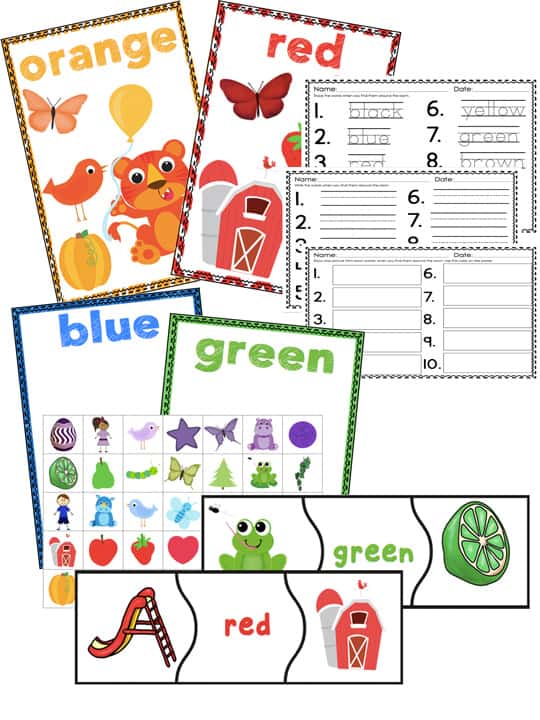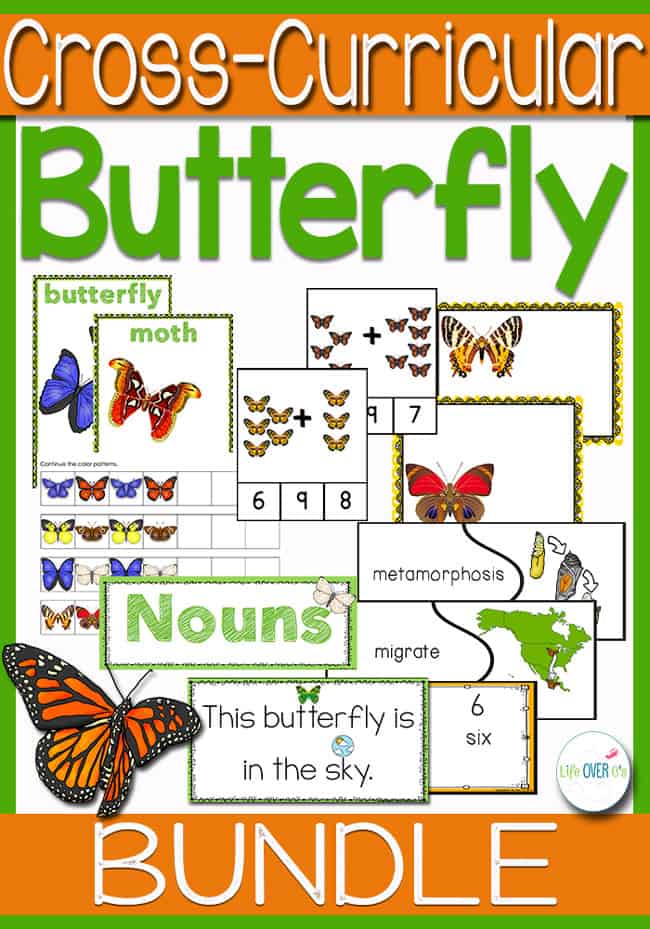Color Recognition Math & Literacy Pack: 15 Activities!
This Color Recognition Math & Literacy Pack is created with little learners in mind. Lots of colorful pictures, fun activities, and multiple levels to make learning colors for toddlers and preschoolers fun. Whether they are exploring measurement with the color measurement mats, graphing with the I Spy-styled pages, playing a dice game or even a card game, these color learning activities are an awesome way to work on math and literacy while learning colors!

Recommended Grade Level:
Learning Colors Activities and Color Recognition Card Games
LEARNING COLORS GAMES AND ACTIVITIES
HANDS-ON ACTIVITIES ARE THE BEST WHEN WE’RE TRYING TO TEACH YOUNG KIDS ANYTHING. GAMES FOR KIDS ARE LOTS OF FUN SO IT DOESN’T GET BORING.
In this pack I included a variety of color recognition printables, sorting activities for kids, puzzles, and matching games to learn and explore primary colors and shapes/common objects, too.
Children learn colors by recognizing and naming them in the environment. We often question toddlers, “What color is your shirt/toy/block?” Without even realizing, we are teaching colors and they are listening!
Learning games provide an interesting way to engage kids. Learning colors worksheets give kids early experiences with writing and coloring on paper, but color recognition worksheets for preschool should never be the only way we teach and explore.
I love the sorting colors games and activities because you can differentiate them for different learners. Kids that are just learning colors will stick to the basics, while kids comfortable naming most colors can branch out and start to compare/contrast/find colors around them.
In addition to the color pack activities and printables, you can encourage thought and conversation before/during/after the activities:
- What is your favorite color? Why?
- Do you have a blue/red/green toy?
- What colors do you see in the back yard?
- What happens when colors mix together?

Preschool Color Recognition Worksheets, Activities, & Games
COLOR ACTIVITIES FOR PRESCHOOL
COLOR RECOGNTION PRINTABLES ARE GREAT WAYS TO PROVIDE VARIED LEARNING FOR COLORS. KIDS WANT COLOR MATCHING GAMES, COLOR LEARNING TOYS, AND ACTIVITIES THAT DON’T FEEL LIKE LEARNING AT ALL.
**This packet is created for color recognition and as such most of the pages require color printing. To make the most of your ink, I strongly advise laminating the materials so that they can be used by many children for many years. There are 66 pages in color and 25 print & go pages. (Plus 20 teacher instruction/credit pages.)
Each activity includes a teacher instruction/suggestion page. Some of the materials, such as the posters, can be used for several activities such as flash cards, write the room and more. You can either print the materials multiple times or use the pieces at different times for the various activities. I did not duplicate the multi-use pages in order to save on file size.

Why Is It Important For Kids To Learn Colors?
Children are naturally curious about everything around them. Educational games about colors helps children to describe and understand the world a little bit better.
Background Knowledge
Color vocabulary is important! Most toddlers start by learning one color and then refer to everything as that color! It takes time and experience to learn that each color has its own name.
Describe
Think of how many times we use color to describe something. When there are two of the same object, but different colors, it makes a world of difference!
Connect with Nature
Identifying colors in pictures and then transferring the knowledge to things that are in the real world helps kids make important connections with the world, nature, and their lives.
Compare/Contrast
Learning color characteristics helps kids sort, compare and contrast with ease. Those are important skills for both reading and math instruction moving forward.
What’s Included in the Color Recognition Pack
Color Posters/Write and Draw the Room, p. 4-11
You can display these colorful posters in your classroom. These can also be used as oversized introductory flash cards. For students needing assistance with language development, such as ESL learners, you can use the posters to discuss color words, positional words, and size.
Place the posters throughout your classroom. Allow students to walk from poster to poster completing the printables while they get to move around. In the lower right-hand corner of each poster there is a small number that corresponds to the printables.
Three levels are provided:
Page 9: Trace the Room
Page 10: Write the Room
Page 11: Draw the Room (students will draw one picture from each poster using a matching crayon.)
You will also need a copy of the posters on pages 5-9.

Color Match It!, p. 51-54:
Students will match the color words to a corresponding picture. Two versions of the words are included (one in color and one in black), but you only need one version to play the game.

Pattern Mats, p. 19-20, 21-25
You can use these mats for students to practice their patterning skills. 3 different levels of patterns are provided: AB, AABB, ABBA. A blank mat is provided to students to create their own patterns. Note: These patterns are COLOR-based, not identical picture-based.
You can also set this up as a file folder game by attaching the pattern mats to the insides of the folder and attaching an envelope/baggie with the sorting pictures.
You will use the pictures from the Sorting Mats. You may choose to print one set and use it for both activities or print the pages twice to allow for multiple centers to be used at the same time.

Color Graphing, p. 26-37
Students will color spaces on the provided graph to show how many times they see each color. For extra emphasis, I encourage my students to color them the same color as the pictures. To help the students keep track of the items they have already counted, I suggest having them cross the pictures off or using beans/buttons/counters to cover the pictures.

Picture/Color Word Match-Up Mats, p. 38-43
Students will draw a line to connect the picture word to the corresponding picture.

Color Puzzles, p. 44-50:
Students will put together these three-piece puzzles for color and color word recognition. Two levels are included, one with the words in the corresponding color to focus on color recognition and one with the words written in black to focus on word recognition.

Color Sorting Mats, p. 12-20:
These mats will provide students the opportunity to practice their sorting skills. 7 pictures are provided for each color. You can differentiate by limiting the amount of sorting mats and/or pictures you provide for the students to work with.
You can also set this up as a file folder game by attaching the sorting mats to the insides of the folder and attaching an envelope/baggie with the sorting pictures.
Color Clip Cards, p. 55-60:
Students will use clothespins or paper clips to indicate the matching color on these clip-cards.

Color Word Play Dough Mats, p. 61-71:
These play dough mats a great for practicing color words. Students can use corresponding colored play dough to “trace” the words at the top. They can also use a write & wipe marker to practice writing the words on the lower section. Then they can use the blank space to create pictures using the colors on the mats. This is great for students who need to improve their fine-motor skills as they will be rolling, shaping writing with these mats.

Non-Standard Measurement Mats, p. 72-84:
These mats and recording sheets for each of the colors are for practicing non-standard measurements. You or the student will cut out a “crayon ruler” to measure the pictures. The arrows are not exact matches to the crayons, so this is a good opportunity to talk about estimation. The children should estimate to the closest number of crayons to measure the indicated height or length.
A generic recording sheet is included. The student will first write the color word on the page to indicate which Measurement Mat they were working on.

Print & Go Activities, p. 86-110
Roll, Read, & Color (86-88): Roll a die. Color one space on the graph to match the word you roll. Use the color that matches the word. Continue until one color reaches the top of the graph.
Color Word Writing Practice (89-98)
Stamp the Color Words (99-106)
Color Word Finds (107-108)
Color by Number (109-110)

Extend the Activity
Sensory Bin
Fill the sensory bin with black and white pom poms, then hide the color puzzle pieces inside. Kids will have fun pulling them out and piecing them together.
Have a Snack
Pick a color of the day and make a themed snack. Red could include strawberries, red O cereal, red gelatin, or red apples and fruit snacks.
Oral Language
Picture cards are a great place to begin working on oral language. Repurpose the clip cards to practice making complete sentences, like, “The owl is the same color as the pig.”
Get the Color Recognition Math & Literacy Pack!!!!
More Colors Activities You’ll Love:
Free Printable Learning Packs:
Search All Activities
Looking for more? Find exactly what you need here:














Good information to use with children